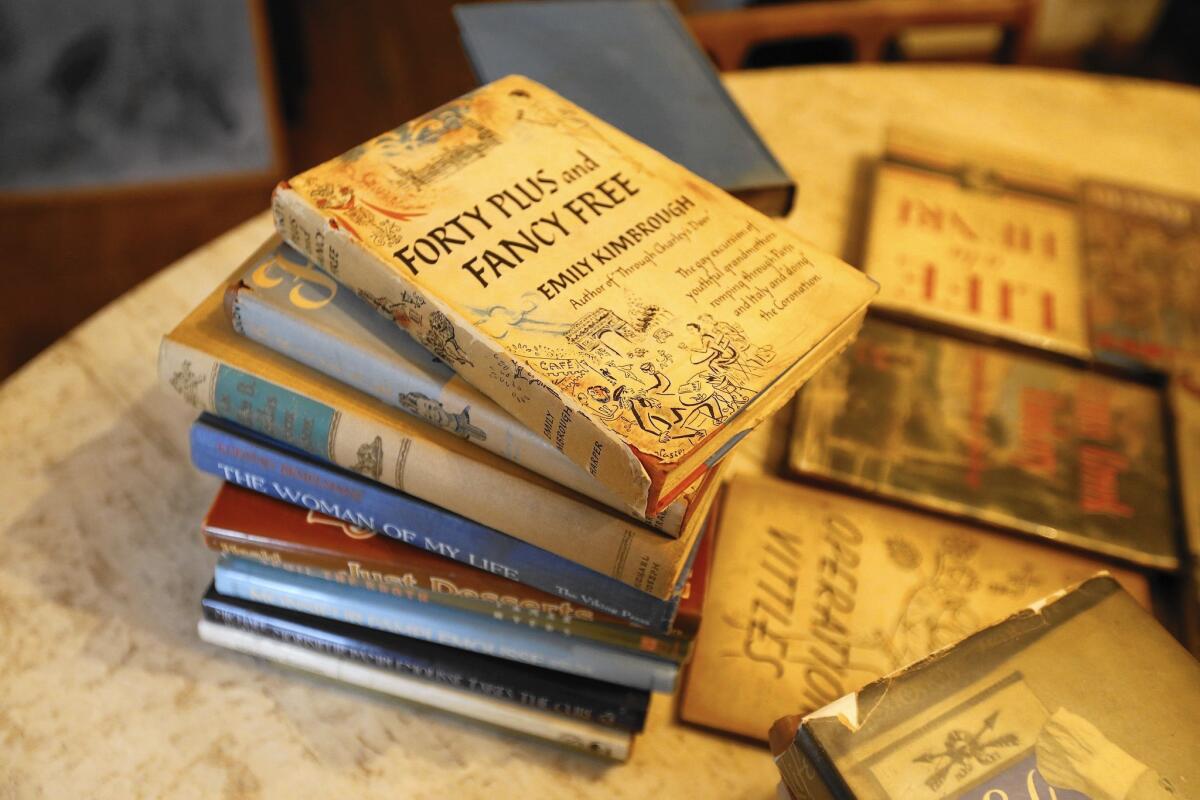My cookbook collection needs to be slimmed down. But how?

- Share via
How do you downsize a lifetime of cookbooks?
I’m planning a move from a spacious apartment to a compact 500-square-foot space. It’s exciting — at least that’s what I’m telling myself. The truth is that since my mother passed away in November, after living with me for the last decade, the house feels too empty. I don’t need a space big enough to accommodate a family. Small is beautiful, right? And the chance to design a compact “great” room is a welcome excuse to spend too much time on Pinterest and Houzz.com. I spend all my time in the kitchen and living room anyway — so I’m creating a space that’s both, and has the benefit of opening to the garden instead of being on the second floor.
But what do I do with the books?
You might call my current décor Eclectic Midcentury Modern Book Hoarder. I think I have a few thousand volumes. It started when I was 8 and my mother told me if I wanted chocolate chip cookies I could, well, make them myself. The plaid “Better Homes and Gardens” cookbook was my gateway drug to food voyeurism. This was how gentiles ate!
Reading “Gourmet’s Old Vienna Cookbook: A Viennese Memoir” — a look at the sumptuous luxury of pre-World War II European dining habits — hooked me. I could travel anywhere, learn about anyone, through the lens of food. So between cookbooks to inform my budding craft and vintage cookbook and culinary memoirs to feed the nascent food anthropologist in me, by the age of 20 I had surpassed the ability of bricks and boards to contain them all. Once I started hosting “Good Food,” the food show on KCRW I’ve been hosting since 1998, the accumulation became ridiculous: I’ve had an average of five books a week sent to me. Since 1998.
Maybe I can jam a couple of hundred into my new space. Maybe more if I use them as bases for the coffee table, bed and desk. But I’ve probably got 50 books on pie alone.
Do I cook from all of these books? Of course not. But I open them for research, context, entertainment and nostalgia — all excellent reasons.
The seriousness of my problem hit me when I got “The Greedy Book” in the mail last week, a 1906 volume published in London with the tantalizing chapter: The Salad in Literature. How could I pass that one up? Enclosed was a note from Celia Sack, owner of Omnivore Books. “So much for culling,” she wrote.
For a while I had the fantasy of getting rid of the same number I took in: one in, one out. In this way I could at least achieve a kind of stasis. But the new cookbook zone piles up so fast that I don’t take the time to differentiate between the ones I’m keeping and the ones I’m not. It makes my heart hurt.
How does anyone choose? There are books I know I will never open again to follow a recipe, but they’re the totems of my development as a cook and thinker about food. They’re the women who taught my generation: Marcella Hazan, Maida Heatter, Julia Child, Ada Boni, Elizabeth David. Then there are the Time Life books I actually got in the mail, one by one, on subscription as a teenager. There are the collectibles, like the gorgeous and wacky “Les Diners de Gala” by Salvador Dalí, and all the cookbooks in Italian collected on trips over 20 years before there was the Internet — or a million YouTube videos.
I treasure my Ludwig Bemelmans collection. You may know him as the author and illustrator of the “Madeline” books; he painted the famed murals in the Bemelmans Bar at the Carlyle Hotel in New York City. But as a young man he spent years waiting tables, then owned a restaurant on the Ile de la Cite in Paris. No one draws waiters or Old World chefs like he does, and the stories of the back-of-house supporting a bygone age of luxurious hospitality are ageless. Those, I’m keeping. But maybe I can let go of the chef books? Can’t someone do an omnibus volume of the text in great chef books? I don’t need the pretty pictures; there’s Instagram for that.
And how many books on sustainable beef does one person need? Or all the monographs: Corn, Sugar, Cod, Oysters. Then there’s a little beauty called simply “Sardines,” with an embossed cover and silver-tinted page edges.
So I think I’ve found the solution: I’m keeping the old. I can find the new online. But I need a deadline and an exit strategy. (Libraries don’t want them; I’ve tried.) Maybe I’ll create an online shop — evansleavings.com or disgorgingmemories.com — and the online shop can raise money for the little great room design, operating as a kind of aesthetic exchange program.
But what happens with the books that just keep on coming?
Kleiman ran Angeli Caffe for 27 years. She’s the longtime host of KCRW’s “Good Food.”
More to Read
Eat your way across L.A.
Get our weekly Tasting Notes newsletter for reviews, news and more.
You may occasionally receive promotional content from the Los Angeles Times.








